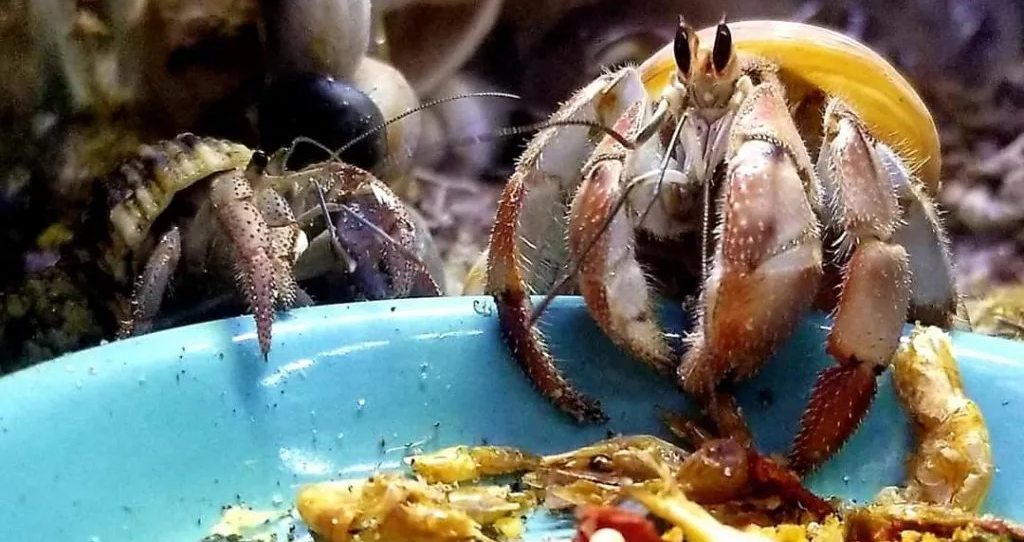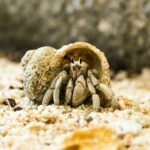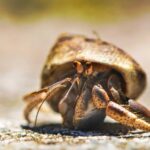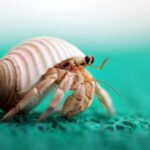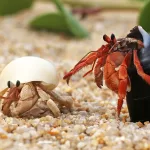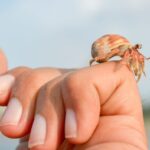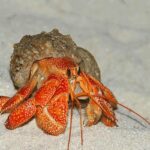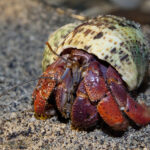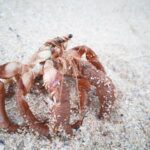As with any pet, choosing the right food for your hermit crab is an important consideration. In our Getting Started and Checklist, we listed several options. There are tons of different options on the market, but all are not safe for your pet. In this brief article, we will tell you what to look out for to ensure that you provide a solid diet to your hermit crab.
Beware of Ethoxyquin
You probably never heard of Ethoxyquin, but it is extremely poisonous to your hermit crab. It is a preservative used in many commercial hermit crab and fish food. It is designed to preserve dried meat. Opinions vary as to whether a small amount in the food is safe; however, it is best to avoid it if all possible.
Other Foods to Avoid
While it is impossible to list every single food that crabs cannot eat, the Crab Street Journal posted a list of foods to avoid. Here are items on their list:
Aconite (Monk’s Hood)
African violet leaves
Alder bark
Aloe vera (interferes with potassium absorption)
Amaryllis
American Hellebore
Anemone/Windflower
Aniseed
Avocado leaves, skin and pit
Azalea/Rhododendron
Bindweed
Bird of Paradise Flowers
Bluebonnet
Bottlebrush flowers
Bougainvillea
Boxwood
Buckthorn
Buttercup
Carnation leaves
Castor Bean
Catnip
Cherimoya Seeds
Chrysanthemum
Cinnamon
Citrus (leaves and branches to be avoided; part of the evergreen family. The fruit is fine)
Columbine
Compost (unless 100% organic)
Crocus
Crown of Thorns
Cube Plant
Custard Apple (young fruit)
Cyclamen
Delphinium
Derris
Dieffenbachia
Dill
Dittany
Eucalyptus
European pennyroyal
Evergreen (pine, cedar, juniper, etc.)
Feverfew
Fleabane
Garlic
Geranium
Golden Pothos
Green hellebore
Hemlock
Holly Berries
Ivy (of any kind)
Juniper Berries
Kalanchoe
Larkspur seed
Laurel
Lavender
Lemon Balm (Sweet Melissa)
Lemon Grass
Lucky Bamboo (Dracaena sanderiana)
Mayweed
Mistletoe
Morning Glory
Mustard plant (wild and wild garlic mustard)
Oleander
Onion
Oxeye daisy
Papaya seed
Parsley Seed (fruit)
Peace Lily
Pencil Tree Cactus
Peppermint
Philodendron
Pine or cedar wood or needles
Prickly juniper
Pride of China fruit
Prunus species trees (apricot, bitter almond, cherry, cherry laurel,
nectarine, peach, plum) Fleshy fruits are edible, everything else
contains a cyanide-like compound and is fatally toxic, including
seeds, wood, leaves, bark and flowers.
Red Emerald
Rosemary
Sago Palm
Sanseveria
Schefflera
Stargazer Lily (Lilium x Stargazer)
Sweet Flag
Tansy
Tea Tree
Texas Mountain Laurel (Sophora secundiflora)
Thornapple
Thyme
Tobacco
Verbena
Vinca
Walnut wood, bark, leaves
Wild Angelica fruit
Wormwood
Yew
Yarrow
What Should You Feed Your Hermit Crabs
So far, we have spent considerable time on what foods to avoid. Now let’s list foods that are good for your hermit crabs:
Alfalfa
Almonds, crushed
Amaranth (Ancient grain – calcium)
Anchovy oil
Apple and natural, unsweetened apple sauce
Apricot (no pit)
Asparagus
Avocado (no skin or pit)
Banana
Barley (calcium)
Bell peppers (red, yellow, orange, green or purple)
Bee pollen
Bilberries/Huckleberries
Blackberry leaves
Blackberry
Bladderwrack
Blueberries
Bone Meal (no additives, preservatives, sold as a supplement for people)
Broccoli and leaves
Brown rice, soy, wheat or 7 grain cereal
Brown rice
Canteloupe
Carnation flowers
Carrots (carotenoids)
Carrot tops (vit. E)
Cat Tails
Cauliflower and leaves
Celery leaves
Chamomile flowers
Chard
Cherimoya
Cherry
Chicken bones
Chicken, cooked and unseasoned (smash the bone for marrow access)
Cholla wood
Cilantro
Clams
Clover blossoms and leaves
Coconut and coconut oil
Cod liver oil
Collards (calcium)
Cooked eggs
Cork bark
Corn (on the cob, too)
Cornflower
Cornmeal
Cranberries (dehydrated)
Cucumber
Currants
Cuttlefish bone, powdered
Dandelion flowers, leaves and roots
Dates
Dragonfruit
Egg
Eggshells
Extra-virgin olive oil
Figs
Fish Oil
Flax seeds (crushed)
Flax seed oil (small amounts infrequently)
Frozen fish food (esp. algae, krill and brine shrimp)
Garbanzos (calcium)
Grape Leaf
Grapes
Grapevine (vines and root)
Green and red leaf lettuce (not iceburg; dark green)
Green Beans
Greensand
Hempseed
Hibiscus flowers
Hikari products: brine shrimp, krill, crab cuisine, sea plankton (ONLY SAFE if no preservatives, ethoxyquin (fish meal), copper sulfate are present)
Hollyhock flowers
Honeydew Melon
Huckleberries/Bilberries
Irish Moss
Impatiens flowers
Jasmine flowers
Kale
Kelp (calcium)
Kiwi
Lobster with crushed exoskeleton
Mango
Marigold flowers (calendula)
Marion Berries
Mint (but not peppermint!)
Most organic baby foods
Mulberry (fruit, leaves, wood)
Mushrooms
Mussels
Nasturtium flowers
Nettle (wilted)
Oak Leaves and bark
Olive and olive oil (extra virgin)
Oranges
Oysters (zinc) and Oyster shell (whole or crushed and buffed, no sharp edges)
Pansy flowers and leaves
Papaya
Parsley (calcium & vit. C)
Passionfruit
Peaches
Peanut butter (avoid sugar, corn syrup and hydrogenated oils)-feed in VERY small drops in a tiny dish to avoid spreading on body, in shell etc
Pears
Pecans
Pecan bark
Petunias
Pineapple
Plain calcium carbonate powder
Popcorn (unseasoned, unflavored, unbuttered)
Potato (no green parts, including eyes)
Quinoa (New World grain – calcium)
Raisins (no sulphur dioxide)
Raspberry
Red raspberry leaves (highest bio available calcium source + vit. C and trace minerals)
Rolled Oats
Rooibus
Rose petals
Rose hips (high in Vit. C)
Royal Jelly
Salmon
Sand dollars
Sardines (calcium)
Scallops
Sea biscuits
Sea fan (red or black)
Sea grasses
Sea salt
Sea Sponges
Sesame seeds (crushed)
Shrimp and exoskeletons
Spinach
Spirulina (complete protein and chlorophyll source; highest in beta carotene)
Sprouts (flax, wheat, bean, alfalfa, etc.)
Squash and blossoms
Strawberry and tops
Sunflower Seeds (crushed), flowers and leaves
Swamp cypress wood (false cypress, taxodium sp.)
Sweet potato
Tangerine
Tomato
Tuna (zinc)
Turnip greens (calcium)
Violet flowers
Walnuts (no wood or bark or leaves)
Wasa All-Natural? Crispbread (Oat flavor)
Watercress (vit. A)
Watermelon
Wheat grass (magnesium)
Wheat (calcium)
Wheat germ (B vitamins)
Whitefish
Whole Wheat Couscous
Worm Castings
Zucchini
Other herb flowers-The tiny flowering blooms of the following spices are edible: anise, basil, bee balm, chives, coriander (cilantro), dill, fennel, garlic, oregano, rosemary, and thyme.
Bugs
Beetle Grubs
Bloodworms
Centipedes
Cicada exo skeletons
Earthworms
Feeder cockroaches
Grasshoppers
Harvestmen
Hornworms
Isopods
Katydids
Locusts
Mealworms
Scorpions
Spiders
Super worms
Waxworms
Hermit Crab Food
There are a lot of options available for food. Hermit Crabs love a variety. Be creative and mix and match different options.
Please note that this page about hermit crab food contains affiliate links. If you use these links to buy something we may earn a commission. Thanks.
